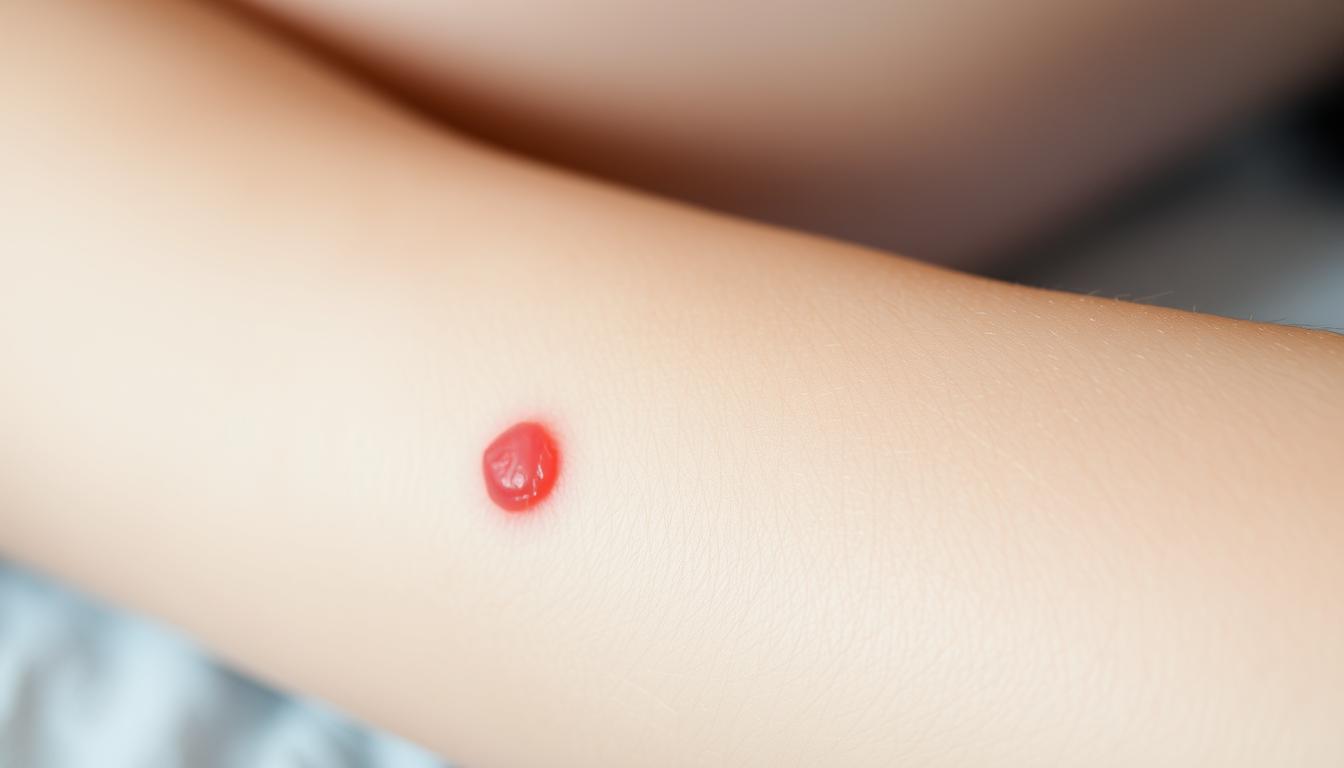
Getting a new tattoo is an exciting experience, but it’s equally important to understand the healing process to ensure your ink looks its best long-term.
The healing process involves several stages, including inflammation control, tissue rebuilding, and surface renewal. During this time, scabbing is a natural part of how your skin heals after getting tattooed.
As your body heals the thousands of tiny wounds created during the tattooing process, it’s normal for protective scabs to form. Understanding what’s normal versus what’s concerning can help you avoid complications that might affect the appearance of your tattoo.
Key Takeaways
- Scabbing is a natural part of the healing process after getting a tattoo.
- Proper aftercare routines are crucial for avoiding complications.
- Normal healing includes skin repair and inflammation, with discomfort typically diminishing within 14 days.
- Watch for unusual symptoms like pus or fever, which could indicate infection.
- Most cases of tattoo scabbing resolve within 2-4 weeks.
Understanding the Tattoo Healing Process
When you get a tattoo, your skin undergoes trauma that triggers a natural healing response. The tattooing process involves puncturing your skin thousands of times with a needle, depositing ink into the dermis, the second layer of skin.
What Happens to Your Skin During Tattooing
During the tattooing process, your body’s natural response is activated, recognizing the needle punctures as an injury. This leads to an inflammatory response, where white blood cells are sent to the area to begin repairs. The tattoo needle creates micro-trauma, with each puncture creating a tiny wound that your body must heal.
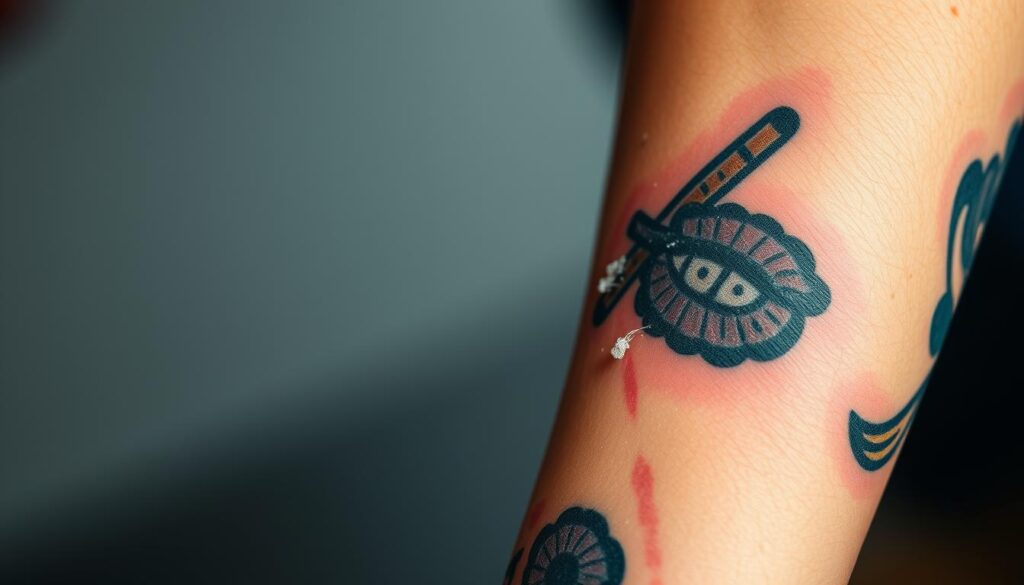
Why Healing Takes Time
The healing process is complex and takes time because your skin regenerates in layers. As explained in our article on how long a tattoo takes to, the initial healing phase begins immediately after your tattoo session, with your body working to repair damaged skin cells and integrate ink particles. The complete healing process can take several weeks, during which proper aftercare is crucial for optimal results.
Is Tattoo Scabbing Normal?
Tattoo scabbing is a common concern for those with new tattoos, but is it actually normal? The answer lies in understanding the difference between scabbing and peeling, and what to expect during the healing process.
The Difference Between Scabbing and Peeling
Many people confuse normal tattoo peeling with scabbing, but they’re actually different healing responses. Peeling is a natural part of the healing process, where the damaged outer layer of skin is shed. This typically occurs around 4-5 days after getting a tattoo.
On the other hand, true scabbing is thicker and more pronounced. While some light scabbing can be normal, excessive scabbing may indicate issues with the tattooing process or aftercare.
What Normal Scabbing Looks Like
Normal tattoo scabbing typically appears as thin, slightly raised areas that match the lines and filled areas of your tattoo. The color of these scabs usually ranges from clear to slightly darker than your natural skin tone, sometimes with a hint of the ink color.
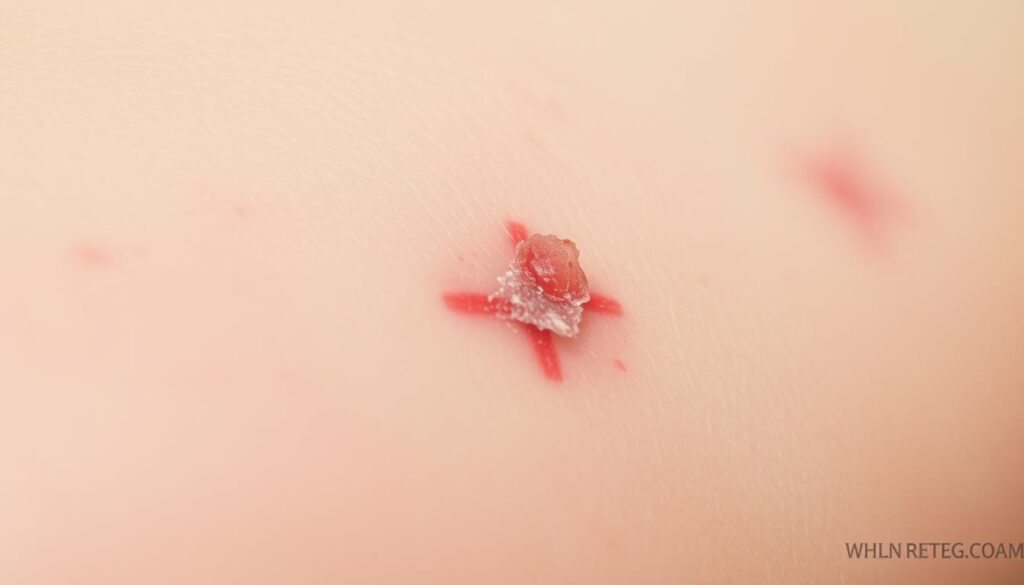
Factors such as the tattoo artist’s technique, your skin type, the location of the tattoo, and how well you follow aftercare instructions can influence scabbing. Understanding what normal scabbing looks like can help you distinguish between the expected healing process and potential problems.
The Stages of Tattoo Healing
Tattoo healing occurs in stages, and knowing what to expect can make a significant difference in your aftercare. The healing process involves several distinct stages, each with its own characteristics and care requirements.
Stage 1: Inflammation and Oozing (Days 1-3)
During the initial stage, your fresh tattoo will likely be red, swollen, and may ooze plasma and excess ink. This is your body’s initial inflammatory response to the tattooing process. Your tattoo artist will typically cover your fresh tattoo with a bandage or wrap that should be kept on for the recommended time, usually between 2 to 24 hours, depending on the covering type. Proper care during this stage is crucial for a healthy tattoo healing process.
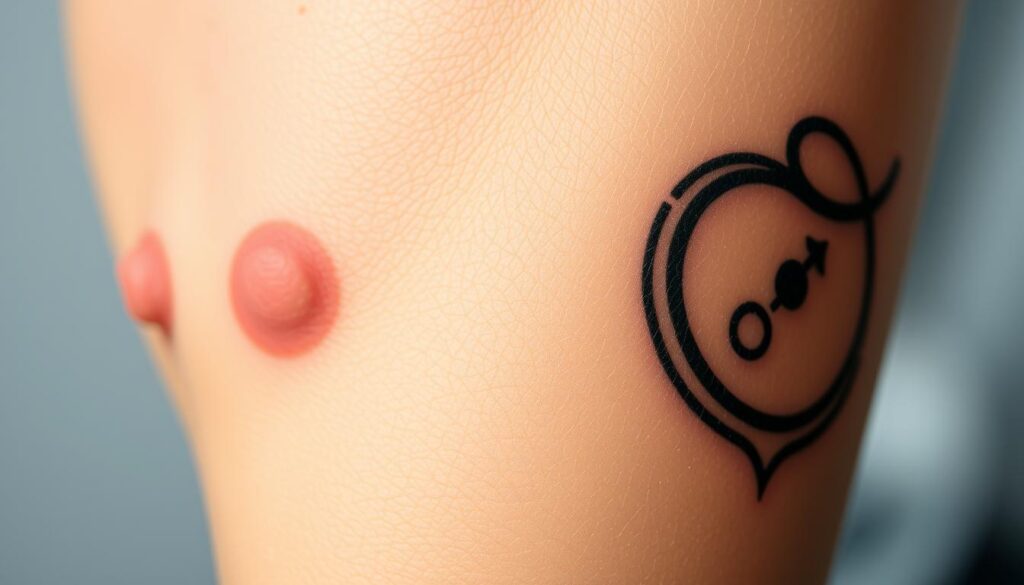
Stage 2: Scabbing and Peeling (Days 4-14)
As your tattoo begins to heal, you will enter the scabbing and peeling stage. Your skin forms protective coverings over the tattooed area while regenerating underneath. During this stage, your tattoo may look dull or cloudy as scabs form – this is temporary and not a reflection of the final result. It’s essential to be gentle with your tattoo during this phase to avoid damaging the skin or disrupting the healing process. For more information on whether tattoos are supposed to peel, you can visit this resource.
Stage 3: Itching and Flaking (Days 7-21)
The final stage of healing brings itching and flaking as the outer layer of skin continues to shed and regenerate. It’s normal to experience some itching during this phase, but it’s crucial to resist scratching to avoid damaging your tattoo or causing infection. Keeping your tattoo moisturized can help alleviate itching and support the healing process.
Signs of Abnormal Tattoo Scabbing
Tattoo scabbing is a natural part of the healing process, but being aware of the signs of abnormal scabbing is crucial. While some scabbing is normal, certain indicators can suggest that your tattoo isn’t healing properly.
When to Be Concerned About Your Healing Tattoo
Abnormal scabbing often appears much thicker than normal, with dark, crusty scabs that may cover large portions of the tattoo. If you notice excessive redness, warmth, and swelling that increases rather than decreases after 3-5 days, it could indicate an infection requiring medical attention.
Severe pain that worsens over time is not normal and may indicate complications with your healing tattoo. It’s essential to monitor your body’s response to the tattoo and seek medical help if you experience any unusual symptoms.
Warning Signs of Infection
Some warning signs of infection include pus or colored discharge, especially if it’s yellow or green. Swelling and redness around the tattoo area, along with fever, chills, or feeling generally unwell, can also be indicative of an infection. Additionally, scabs that appear wet, oozing, or have a foul odor require immediate attention.
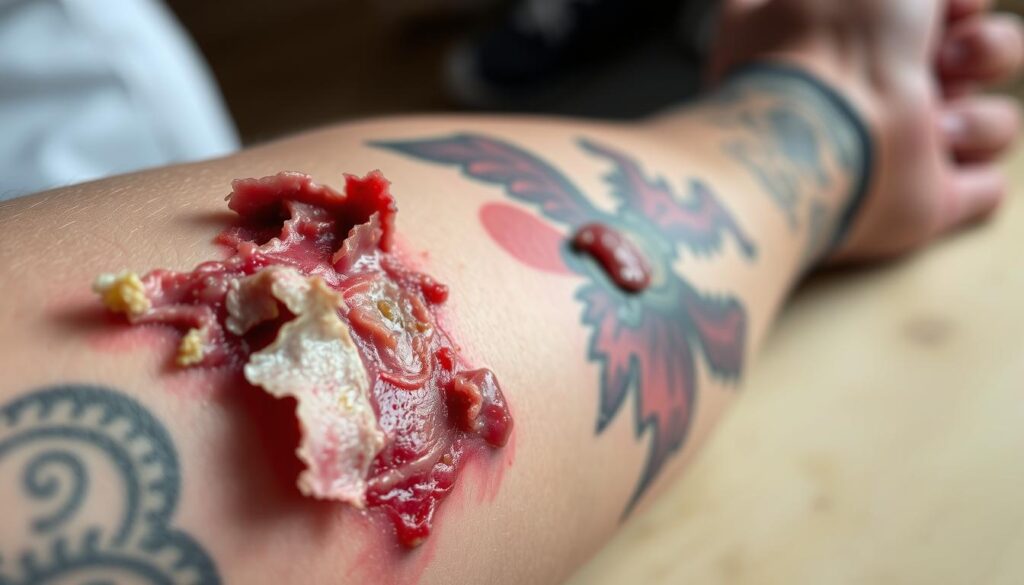
If you notice any of these symptoms, it’s crucial to seek medical care to prevent further complications. Red streaks extending from the tattoo area can indicate a spreading infection that requires urgent medical care.
Proper Tattoo Scab Aftercare
A well-maintained aftercare routine can significantly impact the healing process of your tattoo. Proper care ensures that your tattoo heals with minimal scabbing and achieves optimal results.
Cleaning Your Scabbing Tattoo
To clean your scabbing tattoo, use lukewarm water and a mild, fragrance-free antibacterial soap. Gently wash the area with clean hands, avoiding scrubbing or using a washcloth. Pat the tattoo dry with a clean paper towel or soft cloth to prevent irritation.
Moisturizing Techniques
After cleaning, apply a thin layer of tattoo-safe, fragrance-free moisturizer to keep your skin hydrated. This supports healthy healing and prevents dryness. Be cautious not to over-moisturize, as this can soften the scab and hinder the healing process.
Protecting Your Healing Tattoo
Protecting your healing tattoo from external factors is crucial. Avoid direct sunlight, swimming pools, hot tubs, and saunas until your tattoo is fully healed. Wear loose, breathable clothing to minimize friction that could irritate or dislodge scabs prematurely.
| Aftercare Tips | Benefits |
|---|---|
| Cleaning with lukewarm water and mild soap | Prevents infection and promotes healing |
| Applying a thin layer of moisturizer | Keeps skin hydrated and supports healthy healing |
| Avoiding direct sunlight and harsh environments | Prevents damage to scabs and potential infection |
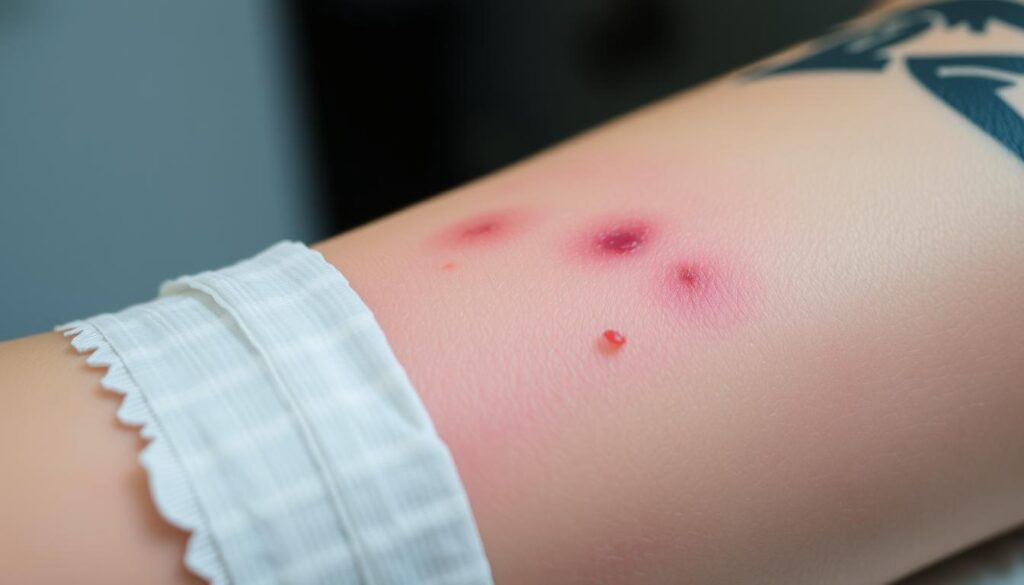
Managing Tattoo Itching During Healing
Itching is an inherent part of the tattoo healing process, occurring as new skin cells form beneath the scabs. This natural process can be challenging to manage, but understanding why it happens is key to dealing with it effectively.
Why Tattoos Itch When Healing
Itching is one of the most challenging parts of the tattoo healing process, typically occurring as your skin regenerates and scabs begin to dry out. The itching sensation is a natural part of healing as new skin cells form beneath the scabs. However, scratching can cause serious damage to your tattoo.
Safe Ways to Relieve Tattoo Itching
To relieve itching, applying a thin layer of appropriate moisturizer can help by keeping the skin hydrated as it heals. Other methods include using cold compresses (not directly on the skin) to temporarily numb the area, and gentle patting around (not directly on) the tattoo. Some people find relief using fragrance-free, hypoallergenic lotions specifically formulated for tattoo aftercare. If itching is severe or accompanied by other concerning symptoms, consult your tattoo artist or a healthcare professional as this could indicate complications.
Do’s and Don’ts for Tattoo Scabbing
The scabbing phase of a tattoo is critical, and knowing what to do and what to avoid is essential. Following the right aftercare practices can make a significant difference in how your new tattoo heals.
What to Do for Healthy Healing
To promote healthy healing, it’s crucial to keep your tattoo clean and moisturized. Clean your tattoo gently 2-3 times daily with mild soap and lukewarm water, following your tattoo artist’s specific aftercare instructions. After cleaning, apply a thin layer of appropriate moisturizer to keep the tattoo from drying out excessively. Wearing loose, breathable clothing can also help prevent irritation and damage to the forming scabs. Additionally, protecting your healing tattoo from direct sunlight is vital, as it can fade the ink and increase the risk of complications.
| Aftercare Practice | Benefit |
|---|---|
| Cleaning with mild soap | Prevents infection |
| Moisturizing | Keeps tattoo hydrated |
| Protecting from sunlight | Preserves ink color |
What to Avoid During the Scabbing Phase
There are several things you should avoid during the scabbing phase to prevent complications. Don’t pick, scratch, or peel your scabs, as this can lead to scarring and ink loss. Avoid soaking your new tattoo in water, such as swimming pools, hot tubs, and long showers, until it’s fully healed. It’s also advisable to avoid intense workouts that cause excessive sweating during the initial healing phase. Lastly, refrain from applying petroleum-based products, as they can draw ink out of your skin and hinder the healing process.
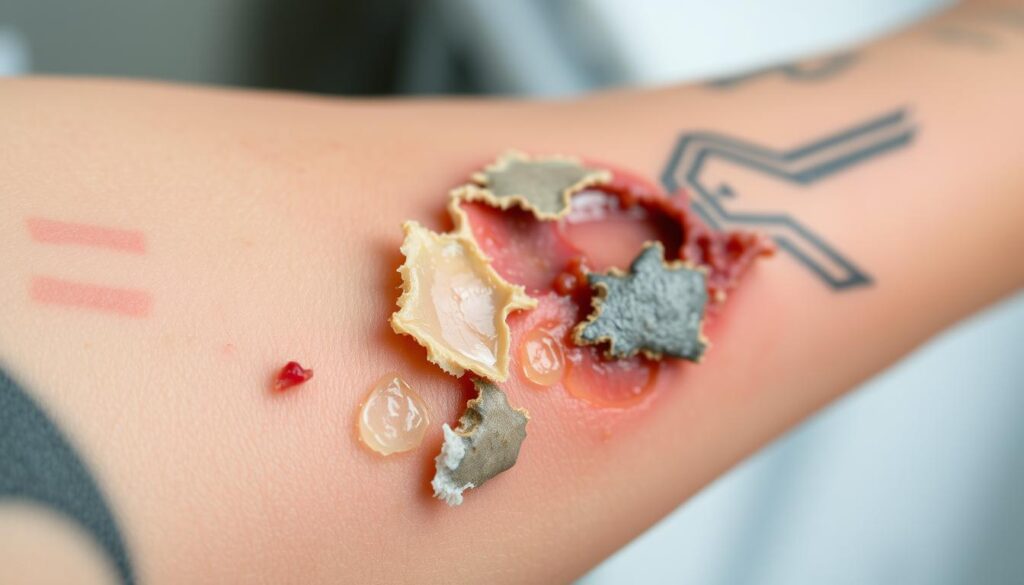
Conclusion
As you navigate the tattoo healing process, understanding the role of scabbing is crucial. Proper aftercare is essential to ensure your new ink heals correctly and looks its best. Following your tattoo artist’s instructions is key to minimizing complications. Remember, each person’s healing process is unique, and factors like skin type and tattoo size can affect how your tattoo scabs and heals. For more information on the tattoo process, you might wonder if tattoos hurt. By being patient and giving your tattoo the care it needs, you’re investing in the quality and appearance of your body art, ensuring your ink remains vibrant for years to come.
